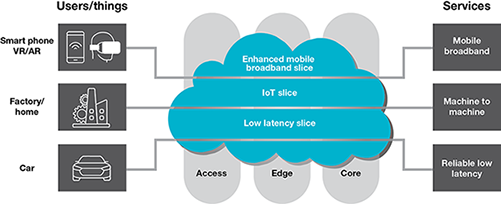SSZT552 January 2019
5G is not just another “G” in the evolution of communications. It will revolutionize connectivity, providing a programmable link between users and cloud services.
With a seamless, ubiquitous, integrated experience across different environments and devices, 5G will provide one network for all use cases, from home to enterprise environments. It will connect billions of things (an estimated 18 billion by 2022, according to the Cisco Visual Networking Index) that are always online, each with their own slice of network, dynamically established to provide a dedicated profile of priority, security, speed and latency.
| Learn more about the 5G infrastructure ecosystem. | |
| Our white paper reviews the trends, characteristics and key hardware of the 5G future. | |
What Is Network Slicing?
One of the characteristics that sets 5G apart is network slicing, as shown in Figure 1. Network slicing allows operators to support multiple applications and services running parallel for the different applications/users that require diverse characteristics of the 5G network. For example:
- Enterprise campuses and similarly smart communities and home automation can benefit from millimeter-wave fixed wireless coverage.
- Mission-critical applications like remote surgery, autonomous driving and Industry 4.0, as well as those with larger geographical footprints like intra-city wireless backhauls and smart grids, require ultra-reliable and/or low-latency characteristics and will be enabled by lower-spectrum frequencies.
 Figure 1 5G Network Slicing
Figure 1 5G Network Slicing5G brings a new stage in the convergence between cloud and telecommunications services – requiring significant infrastructure changes to the network, both in new radio access and backhaul and in the core, bridging wireless and wired communications. Among the subjects of intense rollout are smarter antennas (active antenna systems) and small cells to increase coverage and capacity, more artificial intelligence on demand in the network to enable new business opportunities, and localization of that function in the cloud or at the edge according to the required level of network service from the user.
To withstand the 8x traffic increase from now to 2023, the 5G network will enable higher efficiency and flexibility in the network through the use of virtualization, offering modular network functions and orchestrating programmable network resources to enable the required levels of service. The dual-mode core network, with 4G (5G non-stand-alone) and 5G developing together for many years to come, is already in rapid development from most communication service providers and over-the-top (OTT) players.
What Are Some of the Anticipated Features of 5G?
These are some of the anticipated key features of the 5G network, enabling instant transfer rates and near-zero delay:
- Cost per gigabit may be reduced 10x, thanks to network efficiency.
- 10-Gbps connection speed (10x throughput increase).
- Ultra-low latency <1 ms (10x decrease).
- Extreme capacity 10 Tbps/km2 (10x increase).
- 10-year battery life for machine-type communication.
- 100x increased traffic capacity.
- 3x spectrum efficiency with massive MIMO (mMIMO) active antenna technology.
TI provides the hardware that will enable 5G, with a wide system solution portfolio dedicated to the application. I recently authored a white paper reviewing some of the key aspects and trends of the incoming 5G infrastructure ecosystem, as well as the key semiconductor product areas and characteristics that will enable such revolutionary hardware.
In addition, 5G will redefine a wide range of industries (autonomous transportation, remote health care, public safety and security, smarter agriculture, manufacturing, cities and infrastructure, energy and utilities, and logistics and retail), enabling new business cases and transforming the way humans and machines connect and interact. Self-flying cars, interactive robots and talking holograms are just a few examples of applications that were once only possible in sci-fi movies and are now coming to reality, thanks to innovations in connectivity brought by 5G.